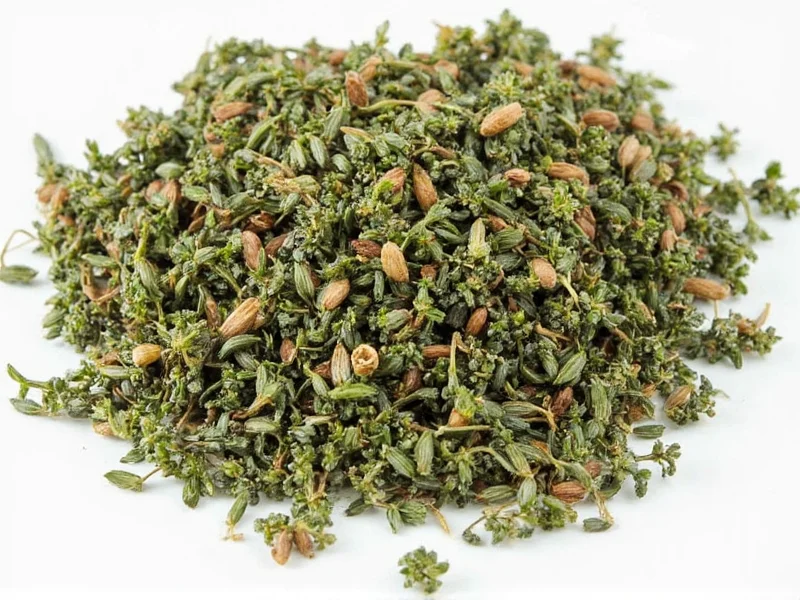Understanding herb conversions is essential for achieving perfect flavor balance in your cooking. When a recipe calls for fresh thyme but you only have dried thyme available, knowing the proper substitution ratio prevents your dishes from becoming either bland or overpowering. The general rule of thumb across culinary professionals is that dried herbs are approximately three times more concentrated than fresh herbs due to the removal of water content during the drying process.
Thyme, whether fresh or dried, brings a distinctive earthy, slightly minty flavor to dishes. However, the drying process intensifies its essential oils, making the dried version significantly more potent. This concentration difference explains why you need less dried thyme to achieve similar flavor intensity as fresh thyme.
| Measurement | Fresh Thyme | Dried Thyme Equivalent |
|---|---|---|
| Basic Ratio | 3 parts | 1 part |
| Teaspoon | 1 tablespoon | 1 teaspoon |
| Tablespoon | 3 tablespoons | 1 tablespoon |
| Cup | 3 cups | 1 cup |
When substituting dried thyme for fresh in your recipes, consider these practical tips for optimal results. Add dried thyme earlier in the cooking process than you would fresh thyme, as it needs time to rehydrate and release its flavors fully. For soups, stews, and braises, add dried thyme at the beginning of cooking. In quicker cooking methods like sautéing, add dried thyme about 15-20 minutes before the dish is complete.
The quality of your dried thyme significantly impacts the final flavor of your dish. Properly stored dried thyme maintains its potency for 1-2 years, but gradually loses flavor over time. To test if your dried thyme is still potent, rub a small amount between your fingers and smell it. If the aroma is weak or musty, it's time to replace it. Store dried thyme in an airtight container away from heat, light, and moisture to preserve its flavor.
Certain dishes work better with specific thyme forms. Fresh thyme shines in delicate preparations like salads, garnishes, and quick-cooking vegetable dishes where its subtle flavor and visual appeal enhance the final presentation. Dried thyme excels in long-simmering dishes like soups, stews, marinades, and sauces where its concentrated flavor can fully develop and distribute throughout the dish.
Avoid common substitution mistakes that can ruin your recipes. Never use a 1:1 ratio when substituting dried for fresh thyme, as this will result in an overwhelmingly strong flavor. Similarly, when converting from dried to fresh, don't simply triple the amount without considering the dish's cooking time and method. For cold dishes like salad dressings or compound butters, fresh thyme generally provides better flavor distribution than dried.
Professional chefs often adjust the standard dried thyme equivalent based on the specific dish and personal taste preferences. Some recommend using slightly less than the full equivalent (about 3/4 teaspoon dried instead of 1 teaspoon) for more delicate dishes, while heartier stews might benefit from the full equivalent or even a touch more. Always remember that seasoning is personal, and these ratios serve as starting points for your culinary experimentation.
Understanding dried herb conversions extends beyond just thyme. Most dried herbs follow the same 1:3 ratio principle, though some like basil and tarragon have more delicate flavors that diminish significantly when dried, making fresh versions preferable when available. Robust herbs like rosemary, oregano, and sage maintain their flavor well when dried and often work better in dried form for certain applications.
What is the exact dried thyme equivalent for fresh thyme in recipes?
The precise dried thyme equivalent is 1 teaspoon of dried thyme for every 1 tablespoon (3 teaspoons) of fresh thyme. This 1:3 ratio accounts for the concentration of flavors that occurs during the drying process, as dried herbs are typically three times more potent than fresh herbs due to water removal.
Can I use dried thyme instead of fresh thyme in all recipes?
While you can substitute dried thyme for fresh in most recipes, the substitution works best in cooked dishes like soups, stews, and braises where dried thyme has time to rehydrate. For raw applications like salads or as a fresh garnish, fresh thyme is preferable as dried thyme won't provide the same texture or immediate flavor release.
How should I adjust cooking time when using dried thyme instead of fresh?
Add dried thyme earlier in the cooking process than fresh thyme—typically at the beginning of cooking for soups and stews, or about 15-20 minutes before completion for quicker dishes. This allows time for the dried herb to rehydrate and release its concentrated flavors fully throughout the dish.
Does the quality of dried thyme affect the substitution ratio?
Yes, older or lower-quality dried thyme may have lost some potency, potentially requiring slightly more than the standard 1:3 ratio. Freshly dried thyme from a reputable source will follow the standard conversion more accurately. Always check the aroma of your dried thyme—if it's weak, you might need to increase the amount slightly.
Why is dried thyme more potent than fresh thyme?
Dried thyme is more potent because the drying process removes water content while concentrating the essential oils and flavor compounds. Fresh thyme is about 80-90% water, so when that water is removed during drying, the remaining plant material contains a much higher concentration of the flavorful compounds that give thyme its distinctive taste and aroma.











 浙公网安备
33010002000092号
浙公网安备
33010002000092号 浙B2-20120091-4
浙B2-20120091-4